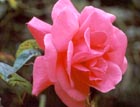Roses that will Bloom in the Shade
Roses can fade in the sunlight making some shade desirable - particularly when growing those with deeper hues, finds David Wheeler.


July 20, 2006
Anyone who gardens in the lee of a purposely planted shelterbelt should be eternally grateful to a previous generation's forethought. Wind, after all, is the great destroyer. But there can be a downside to this highly valued protection: shade. Here at Bryan's Ground, the garden benefits from a well-sited clump of fir, lime, oak and cherry trees. It stands to the south-west of the walled garden, directly between it and prevailing gales that can rush in from the Radnor Forest at any season.
The mature, steadfast trees do a marvellous job, but their close proximity to the garden itself means they throw shade for most of the day over one section of the walled garden. Shade is not a problem if you're making a woodland glade, of course, but the walled garden didn't seem the place for yet more woodlanders. It is a highly formal space, with garden rooms planted in a wide variety of styles and colour themes.
And although we could have used the shady area differently, we defiantly built arbours, pergolas, tunnels and fences?for roses. We call it our Cabinet of Roses, and the shrub and climbing kinds number more than 40 in a square just 30ft by 30ft.
Roses, we are told, thrive in full sun, yet a glance at the literature quickly reveals many which are shade-tolerant. (I am talking here of sunless situations, but not actually under the canopies of trees, which is asking too much of any rose.) I once spent a magical day in the company of the late and great rose expert, Graham Stuart Thomas, who led me through his collection of Old Roses at Mottisfont Abbey, in Hampshire. By the end of the day, both my head and my notebook were chock-a-block with names and fragrances and snippets of esoteric rose lore.
Our barrel-vaulted pergolas carry Madame Alfred Carrière, Alexandre Girault, New Dawn, Russelliana and Souvenir du Docteur Jamain. Indeed, Dr J will take full shade, its deep-wine-red blooms appearing spasmodically long after the main June flush. Russelliana (aka Old Spanish Rose, Russell's Cottage Rose, and Scarlet Grevillei) will, Gollum like, also thrive in your darkest corners, its fading blooms a perfect match for the magenta flowered Gera-nium psilostemon that we've allowed to grow around it.
I'm particularly fond of striped roses. Although I don't grow the ever popular and truly antique R. gallica versicolor (another rose happy in a sunless position), I have found room for Ferdinand Pichard (two-toned flowers the colour of stewed mulberries bleeding into stirred cream) and the somewhat leggy Honorine de Brabant, which will double as a climber.
Exquisite houses, the beauty of Nature, and how to get the most from your life, straight to your inbox.
The peculiar allure of dark roses has not been overlooked. Capitaine John Ingram will fade in bright sunshine, but maintains its deep maroon countenance in semi-shade. The Capitaine is a Moss Rose, less 'whiskered' than its companion, the well-named Chapeau de Napoln (another variety that masquerades under different names: Cristata and Crested Moss), which is heavily-scented and bristling all over with stiff hairs.
Scent, of course, is paramount, and among my shade tolerants are many which exude an exquisite perfume redolent of the most expensive Jermyn Street toiletries. Two favourites are Comte de Chambord and Queen of Denmark, and both share the same clear pink complexion.
Catholics will recognise the myrrh fragrance of Constance Spry, an English Rose bred by David Austin in 1960, which carries many desirable old-fashioned qualities. It is pinned to a brick wall above a bench at Mottisfont, thoughtfully placed for anyone who wants to relive a religious upbringing. I doubt that David Austin (or anyone else for that matter) has improved on Constance Spry in modern times, but the man himself pulled off another masterpiece when he came up with Gertrude Jekyll in 1987.
A few years later, I devoted the best part of an issue of Hortus (Hortus 26, Summer 1993) to roses and, in an article about perfumery, Michael Hayward wrote about Gertrude Jekyll's commercial use. The first har-vest in 1988 yielded 35oz of rose oil to a pioneering solvent extraction technique.
Apparently, 1g of this 'priceless' substance was introduced to 1,000 tablets of soap, which Harrods sold in pairs for ?150. They were snapped up by customers from as far afield as Tokyo, New York and Saudi Arabia, and might even have brought a smile to the redoubtable and eponymous Miss Jekyll herself, had she still been with us. Current and back issues of Hortus can be bought on line fromwww.hortus.co.uk
This article first appeared in COUNTRY LIFE magazine on July 6, 2006
Country Life is unlike any other magazine: the only glossy weekly on the newsstand and the only magazine that has been guest-edited by His Majesty The King not once, but twice. It is a celebration of modern rural life and all its diverse joys and pleasures — that was first published in Queen Victoria's Diamond Jubilee year. Our eclectic mixture of witty and informative content — from the most up-to-date property news and commentary and a coveted glimpse inside some of the UK's best houses and gardens, to gardening, the arts and interior design, written by experts in their field — still cannot be found in print or online, anywhere else.
